Economics Analysis and Decision Making of AI in the Workplace
VerifiedAdded on 2021/06/15
|21
|4697
|241
Essay
AI Summary
This essay provides a comprehensive analysis of artificial intelligence (AI) in the workplace, drawing on concepts from business and economics. It explores the application of AI, its ethical implications, and its impact on decision-making processes. The essay examines the evolution of AI, from assisted to autonomous intelligence, and discusses the ethical concerns surrounding privacy, super-intelligence, and job displacement. Furthermore, it highlights the role of AI in streamlining workplace tasks, improving HR functions, and enhancing employee experiences through tools like chatbots. The analysis includes real-world examples of AI implementation, such as the use of AI in law firms to automate contract review. The essay concludes by emphasizing the importance of understanding AI's influence on business growth and the need to address ethical considerations. This assignment provides a detailed overview of AI's multifaceted role in the modern business environment.
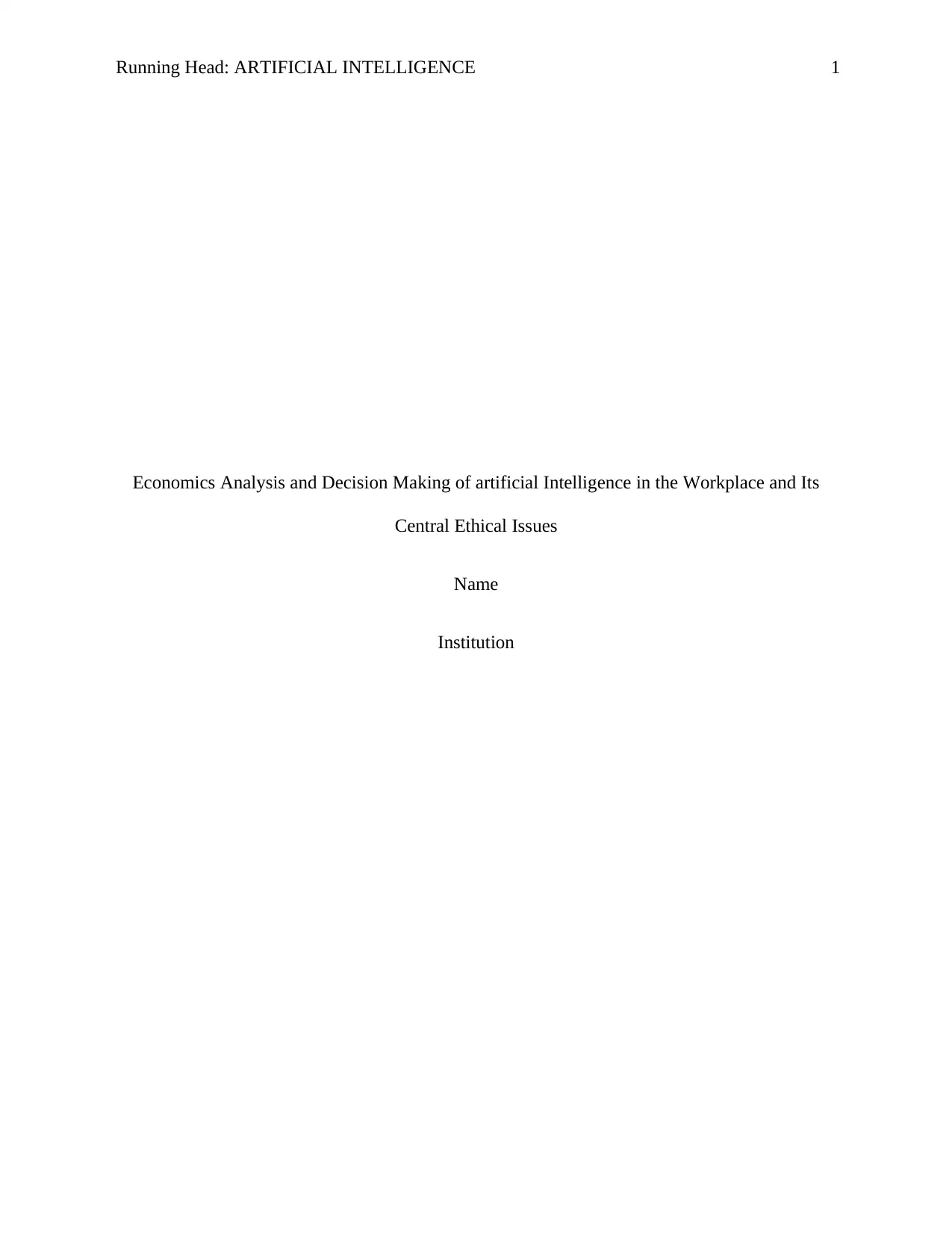
Running Head: ARTIFICIAL INTELLIGENCE 1
Economics Analysis and Decision Making of artificial Intelligence in the Workplace and Its
Central Ethical Issues
Name
Institution
Economics Analysis and Decision Making of artificial Intelligence in the Workplace and Its
Central Ethical Issues
Name
Institution
Paraphrase This Document
Need a fresh take? Get an instant paraphrase of this document with our AI Paraphraser

ARTIFICIAL INTELLIGENCE 2
Abstract
Over the course of this semester, we have had an opportunity to learn about some of the
most important concepts in business and economics. Fundamentally, the course introduced us to
the concept of economic analysis, decision making, and the use of artificial intelligence in the
workplace. As regards to the idea of artificial intelligence in the workplace, the course focus
mainly on the key and central ethical issues that surround their use and implementation in the
work environment. Aside from these key concepts, the course was a broad one, and therefore
provided the learners with an opportunity to gain knowledge on other areas. Thus, this paper is
going to provide a detailed overview of what I have learnt this semester as regards to the concept
of artificial intelligence.
\
Abstract
Over the course of this semester, we have had an opportunity to learn about some of the
most important concepts in business and economics. Fundamentally, the course introduced us to
the concept of economic analysis, decision making, and the use of artificial intelligence in the
workplace. As regards to the idea of artificial intelligence in the workplace, the course focus
mainly on the key and central ethical issues that surround their use and implementation in the
work environment. Aside from these key concepts, the course was a broad one, and therefore
provided the learners with an opportunity to gain knowledge on other areas. Thus, this paper is
going to provide a detailed overview of what I have learnt this semester as regards to the concept
of artificial intelligence.
\
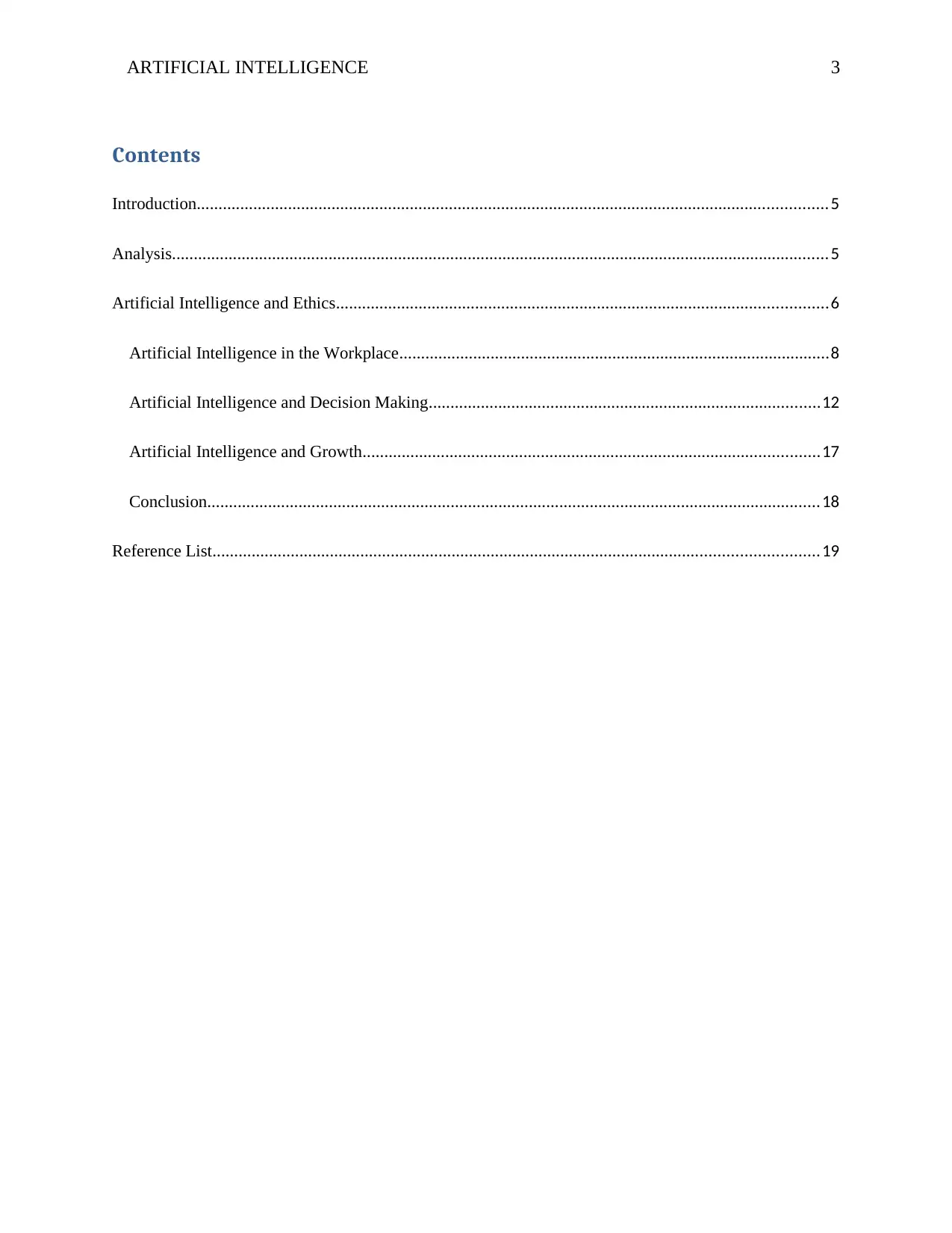
ARTIFICIAL INTELLIGENCE 3
Contents
Introduction.................................................................................................................................................5
Analysis.......................................................................................................................................................5
Artificial Intelligence and Ethics.................................................................................................................6
Artificial Intelligence in the Workplace...................................................................................................8
Artificial Intelligence and Decision Making..........................................................................................12
Artificial Intelligence and Growth.........................................................................................................17
Conclusion.............................................................................................................................................18
Reference List...........................................................................................................................................19
Contents
Introduction.................................................................................................................................................5
Analysis.......................................................................................................................................................5
Artificial Intelligence and Ethics.................................................................................................................6
Artificial Intelligence in the Workplace...................................................................................................8
Artificial Intelligence and Decision Making..........................................................................................12
Artificial Intelligence and Growth.........................................................................................................17
Conclusion.............................................................................................................................................18
Reference List...........................................................................................................................................19
⊘ This is a preview!⊘
Do you want full access?
Subscribe today to unlock all pages.

Trusted by 1+ million students worldwide
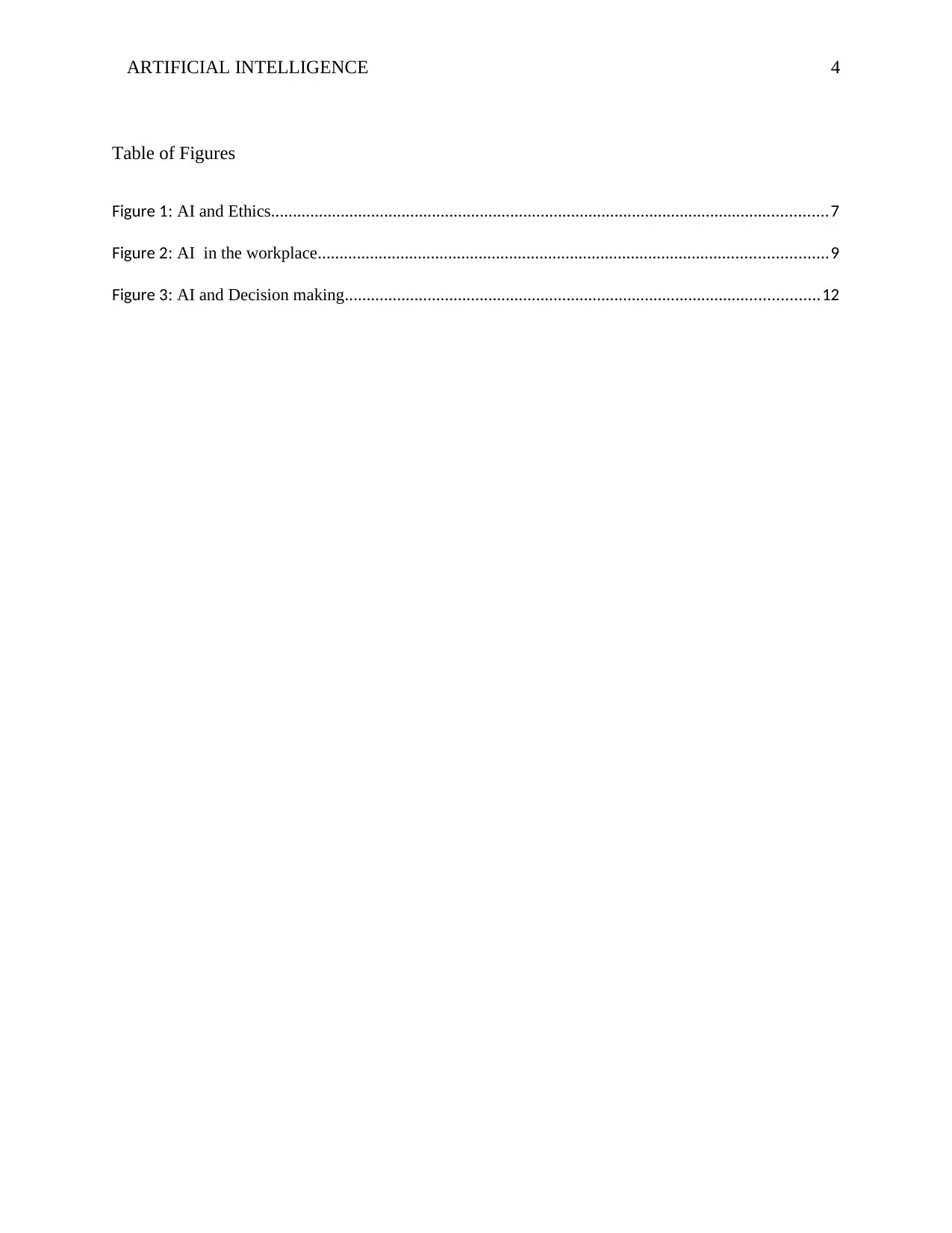
ARTIFICIAL INTELLIGENCE 4
Table of Figures
Figure 1: AI and Ethics................................................................................................................................7
Figure 2: AI in the workplace.....................................................................................................................9
Figure 3: AI and Decision making.............................................................................................................12
Table of Figures
Figure 1: AI and Ethics................................................................................................................................7
Figure 2: AI in the workplace.....................................................................................................................9
Figure 3: AI and Decision making.............................................................................................................12
Paraphrase This Document
Need a fresh take? Get an instant paraphrase of this document with our AI Paraphraser

ARTIFICIAL INTELLIGENCE 5
Economics Analysis and Decision Making of Artificial Intelligence in the Workplace and its
Central Ethical Issues
Introduction
Some of the key topics learnt over the semester in this course include economic primer
and basic principles, horizontal boundaries of the firm, integration and its alternatives, the power
of principles, market analysis, competitive analysis, entry and exit strategies, the dynamics of
competing across time, industrial analysis, strategic positioning for competitive advantage, and
information and value creation. Additionally, the book used for the course explained the concept
of sustaining competitive advantage, measurement of business performance and incentives,
strategy and structure, and even environment, power and culture. Therefore, the course was
particularly important in educating the learner on the most important concepts in business.
However, this paper shall focus on the aspect of artificial intelligence in the workplace and the
main ethical issues surrounding it. By and large, this concept is relevant and important because
Artificial intelligence has become part and parcel of the modern business world. Companies all
over the world are incorporating artificial intelligence into their operations, and it is therefore
important to consider its application as regards the workplace, ethics, decision making as well as
its contribution to the growth of the firm.
Analysis
Artificial intelligence refers to the simulation of human intelligence processes by
technologies such as computer systems. These gadgets are often designed to think like humans
and copy the way people act (Tegmark, n.d.). Over the past few years, artificial intelligence has
Economics Analysis and Decision Making of Artificial Intelligence in the Workplace and its
Central Ethical Issues
Introduction
Some of the key topics learnt over the semester in this course include economic primer
and basic principles, horizontal boundaries of the firm, integration and its alternatives, the power
of principles, market analysis, competitive analysis, entry and exit strategies, the dynamics of
competing across time, industrial analysis, strategic positioning for competitive advantage, and
information and value creation. Additionally, the book used for the course explained the concept
of sustaining competitive advantage, measurement of business performance and incentives,
strategy and structure, and even environment, power and culture. Therefore, the course was
particularly important in educating the learner on the most important concepts in business.
However, this paper shall focus on the aspect of artificial intelligence in the workplace and the
main ethical issues surrounding it. By and large, this concept is relevant and important because
Artificial intelligence has become part and parcel of the modern business world. Companies all
over the world are incorporating artificial intelligence into their operations, and it is therefore
important to consider its application as regards the workplace, ethics, decision making as well as
its contribution to the growth of the firm.
Analysis
Artificial intelligence refers to the simulation of human intelligence processes by
technologies such as computer systems. These gadgets are often designed to think like humans
and copy the way people act (Tegmark, n.d.). Over the past few years, artificial intelligence has
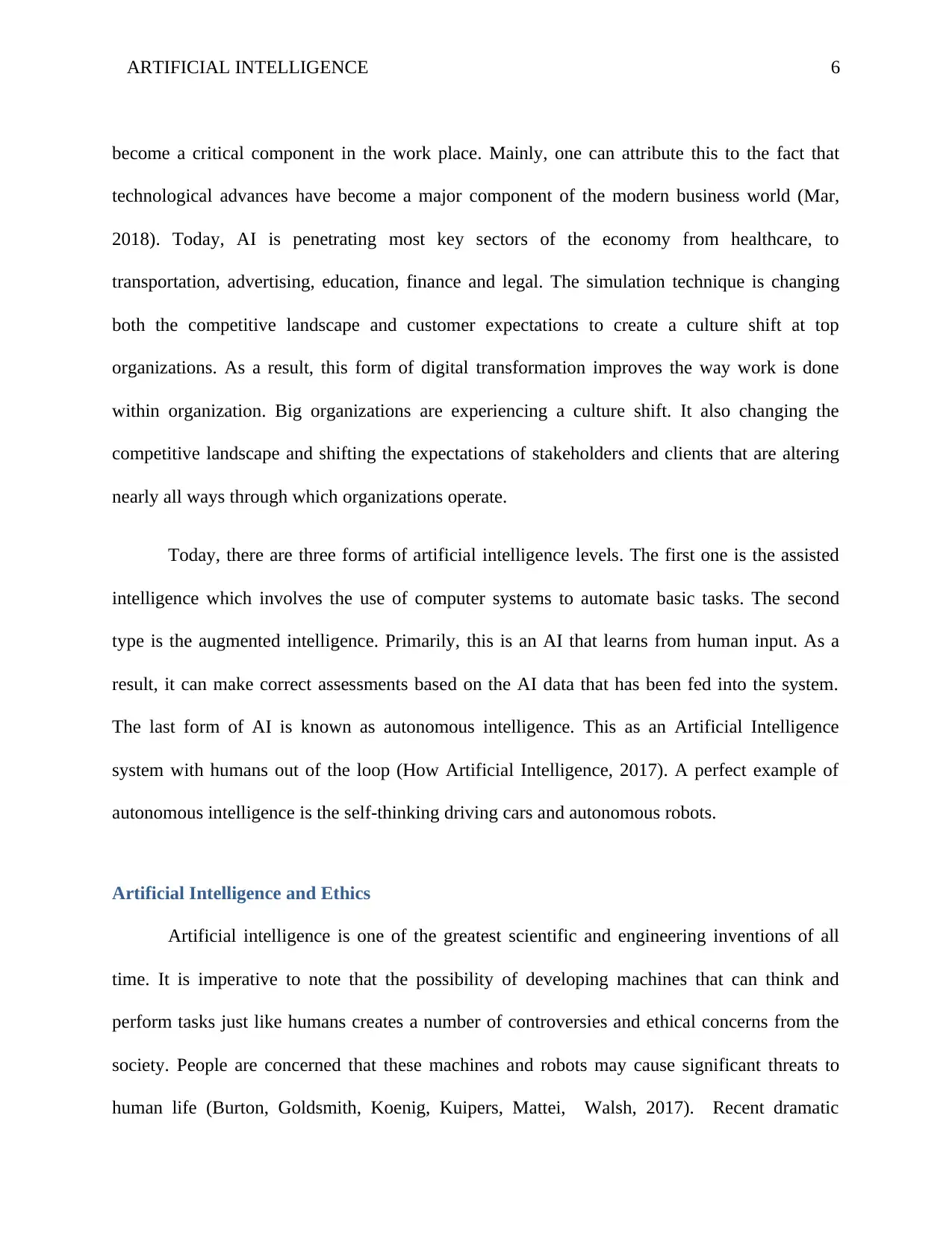
ARTIFICIAL INTELLIGENCE 6
become a critical component in the work place. Mainly, one can attribute this to the fact that
technological advances have become a major component of the modern business world (Mar,
2018). Today, AI is penetrating most key sectors of the economy from healthcare, to
transportation, advertising, education, finance and legal. The simulation technique is changing
both the competitive landscape and customer expectations to create a culture shift at top
organizations. As a result, this form of digital transformation improves the way work is done
within organization. Big organizations are experiencing a culture shift. It also changing the
competitive landscape and shifting the expectations of stakeholders and clients that are altering
nearly all ways through which organizations operate.
Today, there are three forms of artificial intelligence levels. The first one is the assisted
intelligence which involves the use of computer systems to automate basic tasks. The second
type is the augmented intelligence. Primarily, this is an AI that learns from human input. As a
result, it can make correct assessments based on the AI data that has been fed into the system.
The last form of AI is known as autonomous intelligence. This as an Artificial Intelligence
system with humans out of the loop (How Artificial Intelligence, 2017). A perfect example of
autonomous intelligence is the self-thinking driving cars and autonomous robots.
Artificial Intelligence and Ethics
Artificial intelligence is one of the greatest scientific and engineering inventions of all
time. It is imperative to note that the possibility of developing machines that can think and
perform tasks just like humans creates a number of controversies and ethical concerns from the
society. People are concerned that these machines and robots may cause significant threats to
human life (Burton, Goldsmith, Koenig, Kuipers, Mattei, Walsh, 2017). Recent dramatic
become a critical component in the work place. Mainly, one can attribute this to the fact that
technological advances have become a major component of the modern business world (Mar,
2018). Today, AI is penetrating most key sectors of the economy from healthcare, to
transportation, advertising, education, finance and legal. The simulation technique is changing
both the competitive landscape and customer expectations to create a culture shift at top
organizations. As a result, this form of digital transformation improves the way work is done
within organization. Big organizations are experiencing a culture shift. It also changing the
competitive landscape and shifting the expectations of stakeholders and clients that are altering
nearly all ways through which organizations operate.
Today, there are three forms of artificial intelligence levels. The first one is the assisted
intelligence which involves the use of computer systems to automate basic tasks. The second
type is the augmented intelligence. Primarily, this is an AI that learns from human input. As a
result, it can make correct assessments based on the AI data that has been fed into the system.
The last form of AI is known as autonomous intelligence. This as an Artificial Intelligence
system with humans out of the loop (How Artificial Intelligence, 2017). A perfect example of
autonomous intelligence is the self-thinking driving cars and autonomous robots.
Artificial Intelligence and Ethics
Artificial intelligence is one of the greatest scientific and engineering inventions of all
time. It is imperative to note that the possibility of developing machines that can think and
perform tasks just like humans creates a number of controversies and ethical concerns from the
society. People are concerned that these machines and robots may cause significant threats to
human life (Burton, Goldsmith, Koenig, Kuipers, Mattei, Walsh, 2017). Recent dramatic
⊘ This is a preview!⊘
Do you want full access?
Subscribe today to unlock all pages.

Trusted by 1+ million students worldwide

ARTIFICIAL INTELLIGENCE 7
progress in the technology has seen the invention of programs that are able to achieve human
acts such as self-driving cars being able to drive themselves on highways, and city streets with an
excellent safety record. As a result, these inventions have solicited public reaction and concerns
on the potential threats that these machines could pose to humans (Tegmark, n.d.). As such, the
integration of artificial intelligence to human life raises a number of ethical questions. These
questions include how should AIs behave in our society? (Burton et al., 2017). What should we
do is jobs are in short supply? Should AI systems be allowed to kills? Should the society worry
about super-intelligence and the singularity? How should society we treat AIs? (Burton et al.,
2017).
Figure 1: AI and Ethics
Source: (Daily Mail, n.d.)
By and large, the course highlighted the importance of ethics and the issues surrounding
the ethical nature of Artificial intelligence. The goal of teaching this ethical concept was to better
equip the learner with the understanding these challenges by exposing them to various modes of
reasoning and thinking (Bostrom and Yudkowsky, n.d.). As a result, by the end of the lesson, the
progress in the technology has seen the invention of programs that are able to achieve human
acts such as self-driving cars being able to drive themselves on highways, and city streets with an
excellent safety record. As a result, these inventions have solicited public reaction and concerns
on the potential threats that these machines could pose to humans (Tegmark, n.d.). As such, the
integration of artificial intelligence to human life raises a number of ethical questions. These
questions include how should AIs behave in our society? (Burton et al., 2017). What should we
do is jobs are in short supply? Should AI systems be allowed to kills? Should the society worry
about super-intelligence and the singularity? How should society we treat AIs? (Burton et al.,
2017).
Figure 1: AI and Ethics
Source: (Daily Mail, n.d.)
By and large, the course highlighted the importance of ethics and the issues surrounding
the ethical nature of Artificial intelligence. The goal of teaching this ethical concept was to better
equip the learner with the understanding these challenges by exposing them to various modes of
reasoning and thinking (Bostrom and Yudkowsky, n.d.). As a result, by the end of the lesson, the
Paraphrase This Document
Need a fresh take? Get an instant paraphrase of this document with our AI Paraphraser

ARTIFICIAL INTELLIGENCE 8
learner is equipped with the skill to consider a set of problems from different perspectives and
consider each problem in the light of different theories. Primarily, the main ethical concern that
arises from the use of artificial intelligence is the privacy concern. Privacy regards to the
freedom from interference and intrusion. Fundamentally, the Fourth Amendment safeguards and
guarantees the right of an individual to be safe in their persons, papers, houses, and effects
against any unnecessary searches. The law protects the individual against violation of their
privacy and therefore should not be violated and no warrants are to be issued without probable
cause. Warrants are only permissible upon probable cause supported by oath and affirmation.
Today, it is generally agreed that AI technology has given rise to various controversies
pertaining to issues of invasion of privacy and moral concerns. AI applications such as Siri and
Alexa have been known to record private information about people through audio, and can be
used by malicious individuals to take advantage of people. As a result, this has brought about the
debates as regards to whether or not people can still enjoy their privacy while using AI enabled
gadgets. There has also been the aspect of super-intelligence and people are concerned that it
may be one of the biggest existential threats of all times (Burton et al., 2017).
Artificial Intelligence in the Workplace
During the semester, this course emphasized on the importance of Artificial Intelligence
in the workplace (Sharma, 2017). At the moment, Artificial Intelligence has been used in the
form of digital assistants such as Amazon’s Alexa, Microsoft’s Cortana, Google Assistant,
Apple’s Siri, Facebook’s M and Zuckerberg’s Jarvis (Sharma, 2017). Today, companies like
Facebook, Google and Spotify have invested in huge amounts in Artificial Intelligence
learner is equipped with the skill to consider a set of problems from different perspectives and
consider each problem in the light of different theories. Primarily, the main ethical concern that
arises from the use of artificial intelligence is the privacy concern. Privacy regards to the
freedom from interference and intrusion. Fundamentally, the Fourth Amendment safeguards and
guarantees the right of an individual to be safe in their persons, papers, houses, and effects
against any unnecessary searches. The law protects the individual against violation of their
privacy and therefore should not be violated and no warrants are to be issued without probable
cause. Warrants are only permissible upon probable cause supported by oath and affirmation.
Today, it is generally agreed that AI technology has given rise to various controversies
pertaining to issues of invasion of privacy and moral concerns. AI applications such as Siri and
Alexa have been known to record private information about people through audio, and can be
used by malicious individuals to take advantage of people. As a result, this has brought about the
debates as regards to whether or not people can still enjoy their privacy while using AI enabled
gadgets. There has also been the aspect of super-intelligence and people are concerned that it
may be one of the biggest existential threats of all times (Burton et al., 2017).
Artificial Intelligence in the Workplace
During the semester, this course emphasized on the importance of Artificial Intelligence
in the workplace (Sharma, 2017). At the moment, Artificial Intelligence has been used in the
form of digital assistants such as Amazon’s Alexa, Microsoft’s Cortana, Google Assistant,
Apple’s Siri, Facebook’s M and Zuckerberg’s Jarvis (Sharma, 2017). Today, companies like
Facebook, Google and Spotify have invested in huge amounts in Artificial Intelligence

ARTIFICIAL INTELLIGENCE 9
Development. Additionally, other firms in different industries have also firmly entered into the
system are adopting artificial intelligence in their operations.
Figure 2: AI in the workplace
Artificial Intelligence can play an important role in the workplace. Today, the technique
can be used to eliminate bias and lead to a more meritocratic workplace. Over the past few years,
various companies have adopted the program in their operations. According to a study by
Pegasystems and Marketforce, Artificial Intelligence and automation impacts are much more
nuanced, and the program has a positive impact on how employees work (Sharma, 2017). So far,
artificial intelligence has proven very useful in the field of selection, recruitment, performance
reviews, and remuneration policies. According to the study, Sixty-six percent of the respondents
believe that the widespread use of AI will bring about a rise in transparent meritocracy in the
Development. Additionally, other firms in different industries have also firmly entered into the
system are adopting artificial intelligence in their operations.
Figure 2: AI in the workplace
Artificial Intelligence can play an important role in the workplace. Today, the technique
can be used to eliminate bias and lead to a more meritocratic workplace. Over the past few years,
various companies have adopted the program in their operations. According to a study by
Pegasystems and Marketforce, Artificial Intelligence and automation impacts are much more
nuanced, and the program has a positive impact on how employees work (Sharma, 2017). So far,
artificial intelligence has proven very useful in the field of selection, recruitment, performance
reviews, and remuneration policies. According to the study, Sixty-six percent of the respondents
believe that the widespread use of AI will bring about a rise in transparent meritocracy in the
⊘ This is a preview!⊘
Do you want full access?
Subscribe today to unlock all pages.

Trusted by 1+ million students worldwide

ARTIFICIAL INTELLIGENCE 10
workplace (Sharma, 2017). On the other hand, 35 percent believe that the program will result in
a reduction in the level of office politics and bias. In their opinion, the decade long arguments
about bias and privilege could be resolved by the application of machine learning within
organization.
Furthermore, artificial intelligence removes and automates the ordinary and repetitive
tasks in the workplace that are inherent in running a business. By and large, artificial intelligence
is important in the workplace and has a powerful impact on streamlining the tasks. Furthermore,
it is adaptable to various environments and can be applied within a number of departments in a
company and across industries (Pedderson, 2018). It helps in asking basic questions and review
qualifications, allowing HR team to focus on important aspects such as human interactions and
getting to know the candidates better, and on a personal level (Pedderson, 2018). In this regard,
artificial intelligence improves the productivity of Human resource managers through
automation. Also, it can eliminate some of the risks that arise from human error and bias and
allows workers to identify and rectify these issues faster.
The interaction between human resources and artificial in the workplace provides the
promise of creating great value to modern organizations. As noted earlier, AI plays an important
role in selecting, recruiting, hiring, coaching, and employee service and development. Mainly,
this is done through the use of Chatbots. According to a recent survey by ServiceNow that
comprised of 350 HR leaders as respondents, 92 percent agreed that the future of offering an
improved level of employee service will consist of this program (Meister, 2017). In their
opinion, Chatbot is the newest member of the HR team. Mainly, this is due to the fact that the
program allows workers to easily get retrieve solution to frequently asked questions. What is
workplace (Sharma, 2017). On the other hand, 35 percent believe that the program will result in
a reduction in the level of office politics and bias. In their opinion, the decade long arguments
about bias and privilege could be resolved by the application of machine learning within
organization.
Furthermore, artificial intelligence removes and automates the ordinary and repetitive
tasks in the workplace that are inherent in running a business. By and large, artificial intelligence
is important in the workplace and has a powerful impact on streamlining the tasks. Furthermore,
it is adaptable to various environments and can be applied within a number of departments in a
company and across industries (Pedderson, 2018). It helps in asking basic questions and review
qualifications, allowing HR team to focus on important aspects such as human interactions and
getting to know the candidates better, and on a personal level (Pedderson, 2018). In this regard,
artificial intelligence improves the productivity of Human resource managers through
automation. Also, it can eliminate some of the risks that arise from human error and bias and
allows workers to identify and rectify these issues faster.
The interaction between human resources and artificial in the workplace provides the
promise of creating great value to modern organizations. As noted earlier, AI plays an important
role in selecting, recruiting, hiring, coaching, and employee service and development. Mainly,
this is done through the use of Chatbots. According to a recent survey by ServiceNow that
comprised of 350 HR leaders as respondents, 92 percent agreed that the future of offering an
improved level of employee service will consist of this program (Meister, 2017). In their
opinion, Chatbot is the newest member of the HR team. Mainly, this is due to the fact that the
program allows workers to easily get retrieve solution to frequently asked questions. What is
Paraphrase This Document
Need a fresh take? Get an instant paraphrase of this document with our AI Paraphraser

ARTIFICIAL INTELLIGENCE 11
more, employees are very comfortable with accessing Chatbots to obtain information whenever
they need to make clarifications on various matters at the workplace (Meister, 2017). The type of
questions that employees feel comfortable asking using Chatbot range from the general ones to
the factual ones. For instance, they ask questions such as how much paid time off do I have left?
How do I report sexual harassment and misconduct experience at the workplace? (Meister,
2017).Therefore, the AI technology plays an important role in smoothening the HR and
employees experience at the workplace.
In real life, various companies have adopted Artificial Intelligence in the modern
workplace. The organization was a law firm that utilized LawGeex. Primarily, LawGeex is an
open AI review program that reads and analyses legal contracts. The program is able to read a
contract for the company, even if it is a new document that it has never seen before. It can also
compare it to a compilation of analogous contracts that it has seen in the past for future
reference. It is worth noting that LawGeex functions fully just like real lawyers. Specifically, it
remembers what contracts it has seen before in the past for future references. Furthermore, the
program plays the role of cloud testing for the company. Thus it is very useful in test automation.
My experience with the program has shown that Artificial Intelligence can simplify the work in
the workplace, especially for the routine tasks. In this case, it has helped reduce the workload for
the law firm by reducing the large quantity of legal documents that the employees of the firm are
expected to read and inspect. Therefore, by reading through the contracts on behalf the lawyers
at the firm, the workload is significantly reduced. Before the program was introduced and
implemented, employees of the firm were forced to read through a significantly large number of
documents, sometimes repetitively. The large workload and the repetitive nature of the task
more, employees are very comfortable with accessing Chatbots to obtain information whenever
they need to make clarifications on various matters at the workplace (Meister, 2017). The type of
questions that employees feel comfortable asking using Chatbot range from the general ones to
the factual ones. For instance, they ask questions such as how much paid time off do I have left?
How do I report sexual harassment and misconduct experience at the workplace? (Meister,
2017).Therefore, the AI technology plays an important role in smoothening the HR and
employees experience at the workplace.
In real life, various companies have adopted Artificial Intelligence in the modern
workplace. The organization was a law firm that utilized LawGeex. Primarily, LawGeex is an
open AI review program that reads and analyses legal contracts. The program is able to read a
contract for the company, even if it is a new document that it has never seen before. It can also
compare it to a compilation of analogous contracts that it has seen in the past for future
reference. It is worth noting that LawGeex functions fully just like real lawyers. Specifically, it
remembers what contracts it has seen before in the past for future references. Furthermore, the
program plays the role of cloud testing for the company. Thus it is very useful in test automation.
My experience with the program has shown that Artificial Intelligence can simplify the work in
the workplace, especially for the routine tasks. In this case, it has helped reduce the workload for
the law firm by reducing the large quantity of legal documents that the employees of the firm are
expected to read and inspect. Therefore, by reading through the contracts on behalf the lawyers
at the firm, the workload is significantly reduced. Before the program was introduced and
implemented, employees of the firm were forced to read through a significantly large number of
documents, sometimes repetitively. The large workload and the repetitive nature of the task
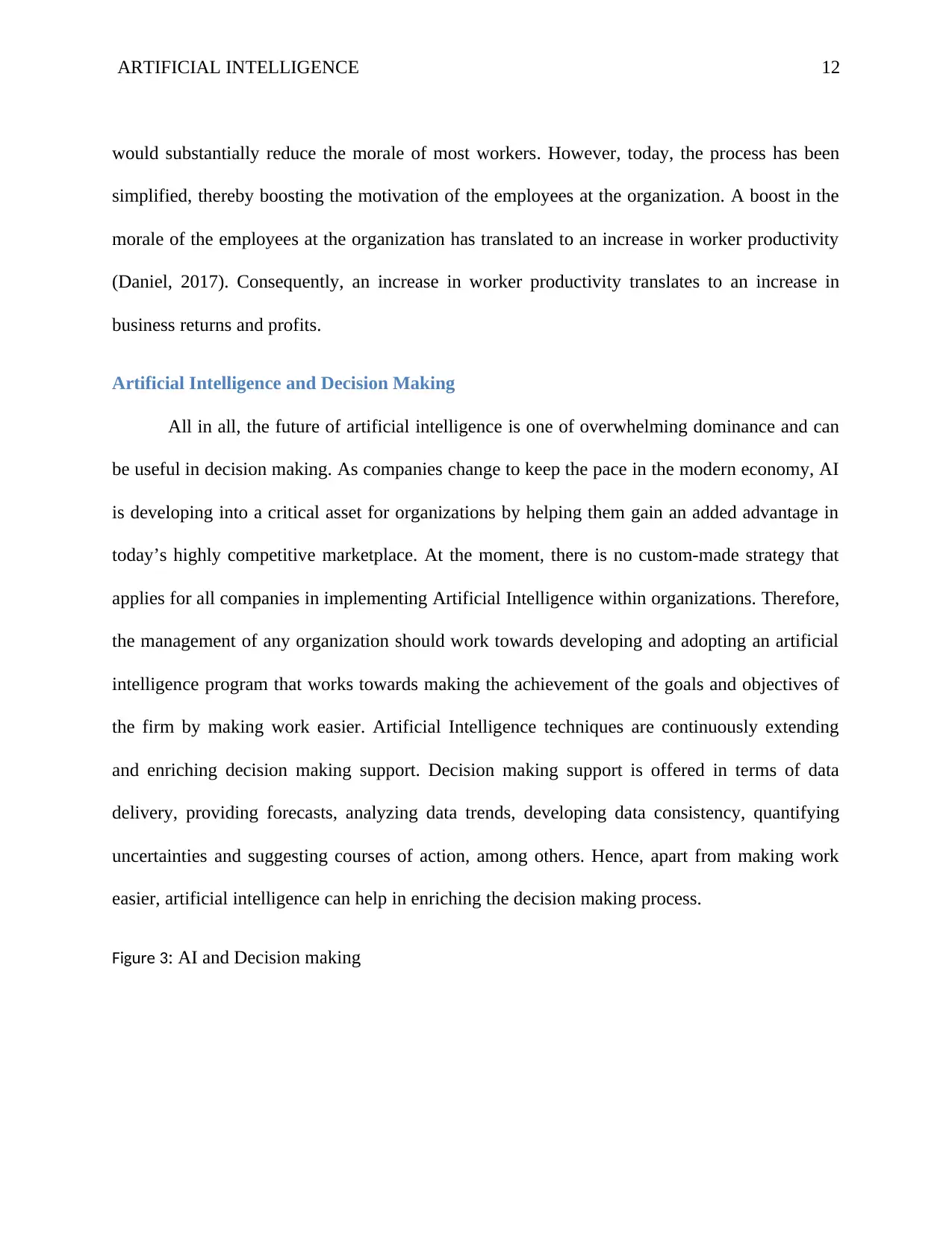
ARTIFICIAL INTELLIGENCE 12
would substantially reduce the morale of most workers. However, today, the process has been
simplified, thereby boosting the motivation of the employees at the organization. A boost in the
morale of the employees at the organization has translated to an increase in worker productivity
(Daniel, 2017). Consequently, an increase in worker productivity translates to an increase in
business returns and profits.
Artificial Intelligence and Decision Making
All in all, the future of artificial intelligence is one of overwhelming dominance and can
be useful in decision making. As companies change to keep the pace in the modern economy, AI
is developing into a critical asset for organizations by helping them gain an added advantage in
today’s highly competitive marketplace. At the moment, there is no custom-made strategy that
applies for all companies in implementing Artificial Intelligence within organizations. Therefore,
the management of any organization should work towards developing and adopting an artificial
intelligence program that works towards making the achievement of the goals and objectives of
the firm by making work easier. Artificial Intelligence techniques are continuously extending
and enriching decision making support. Decision making support is offered in terms of data
delivery, providing forecasts, analyzing data trends, developing data consistency, quantifying
uncertainties and suggesting courses of action, among others. Hence, apart from making work
easier, artificial intelligence can help in enriching the decision making process.
Figure 3: AI and Decision making
would substantially reduce the morale of most workers. However, today, the process has been
simplified, thereby boosting the motivation of the employees at the organization. A boost in the
morale of the employees at the organization has translated to an increase in worker productivity
(Daniel, 2017). Consequently, an increase in worker productivity translates to an increase in
business returns and profits.
Artificial Intelligence and Decision Making
All in all, the future of artificial intelligence is one of overwhelming dominance and can
be useful in decision making. As companies change to keep the pace in the modern economy, AI
is developing into a critical asset for organizations by helping them gain an added advantage in
today’s highly competitive marketplace. At the moment, there is no custom-made strategy that
applies for all companies in implementing Artificial Intelligence within organizations. Therefore,
the management of any organization should work towards developing and adopting an artificial
intelligence program that works towards making the achievement of the goals and objectives of
the firm by making work easier. Artificial Intelligence techniques are continuously extending
and enriching decision making support. Decision making support is offered in terms of data
delivery, providing forecasts, analyzing data trends, developing data consistency, quantifying
uncertainties and suggesting courses of action, among others. Hence, apart from making work
easier, artificial intelligence can help in enriching the decision making process.
Figure 3: AI and Decision making
⊘ This is a preview!⊘
Do you want full access?
Subscribe today to unlock all pages.

Trusted by 1+ million students worldwide
1 out of 21
Related Documents
Your All-in-One AI-Powered Toolkit for Academic Success.
+13062052269
info@desklib.com
Available 24*7 on WhatsApp / Email
![[object Object]](/_next/static/media/star-bottom.7253800d.svg)
Unlock your academic potential
Copyright © 2020–2025 A2Z Services. All Rights Reserved. Developed and managed by ZUCOL.





